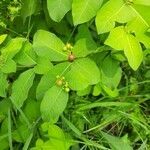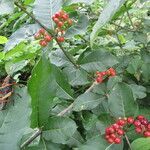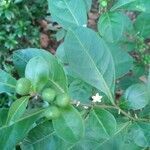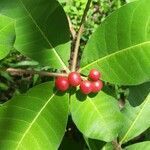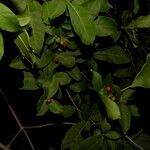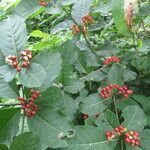Shrub to 1 m high. Leaves 4-whorled; petiole 2–5 mm long; lamina elliptic, elliptic-ovate or broadly elliptic, to 10 cm long, to 6 cm wide, cuneate to rounded, acute to obtuse, discolorous; upper surface dark matt-green, with venation obscure; lower surface pale green, with secondary veins 12 or 13 each side of midrib, and tertiary venation reticulate. Flowers 4–5 mm long, 1.8–2 mm diam.; pedicels 5–10 mm long. Corolla salverform to urceolate, white; tube 3.4–3.7 mm long, 1.8–2 mm diam.; lobes ovate, 1–1.2 mm long, 0.6–0.7 mm wide. Stamens inserted c. 1 mm from top of tube. Disc annular. Fruit syncarpous, globose, 8–10 mm long, 6–8 mm diam.
Shrubs to 2 m tall, pubescent or tomentose when young, glabrescent with age. Leaves in whorls of 3-5; petiole 2-5 mm; leaf blade ovate, narrowly ovate, or oblong, 1-15 X 0.8-4 cm, membranous, base broadly cuneate to rounded, apex acute or obtuse; lateral veins 5-12 pairs. Peduncle 1-4 cm. Corolla white, tube urceolate, 2-3 mm, long hairy inside distal half; lobes ovate or suborbicular. Stamens inserted at corolla throat. Ovaries connate. Drupes subglobose, 5-10 mm in diam., glabrous, connate. Seeds 2. Fl. May, fr. Jun-Aug. 2n = 66.
